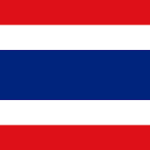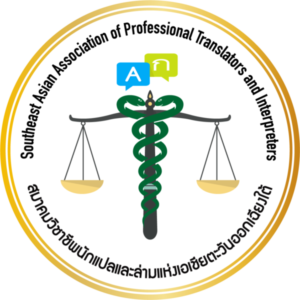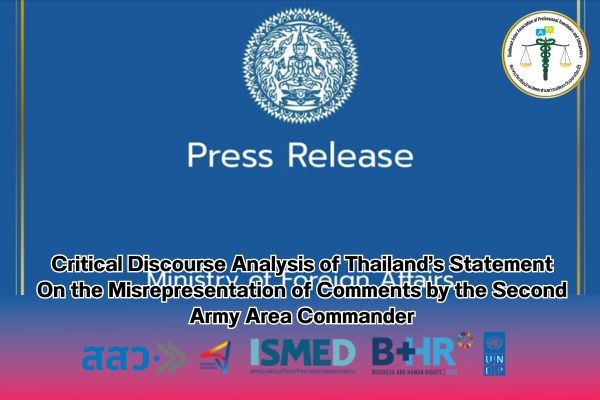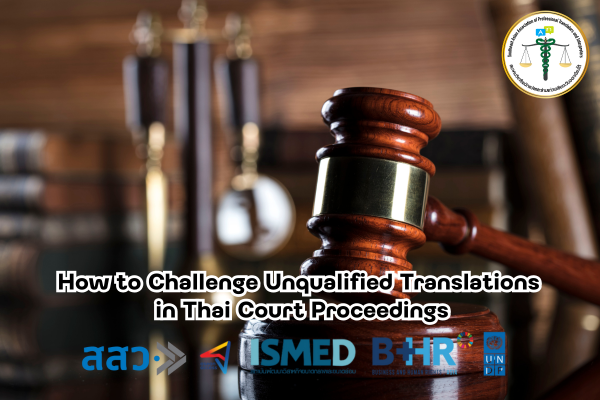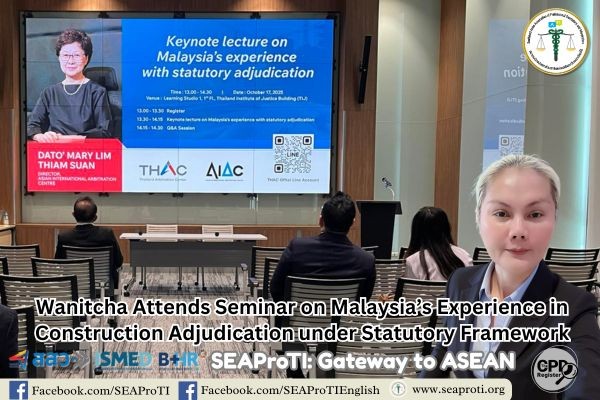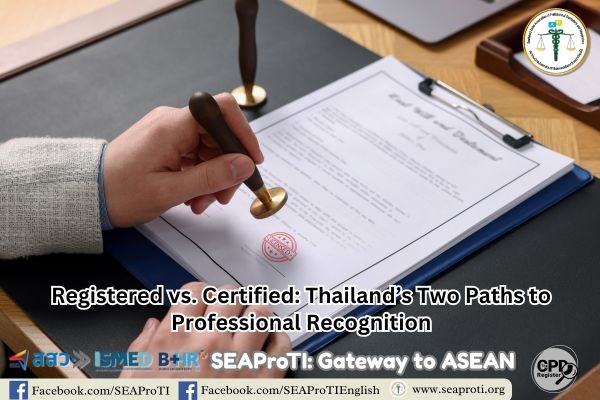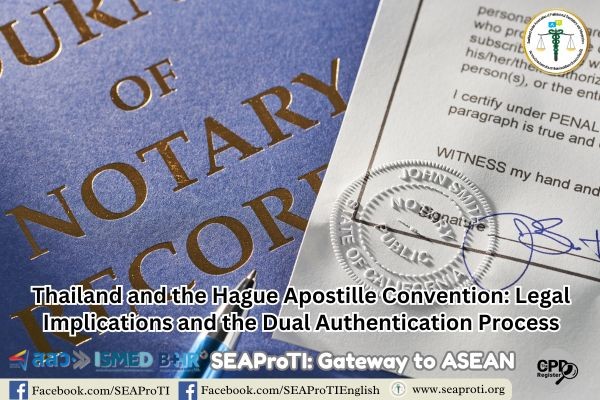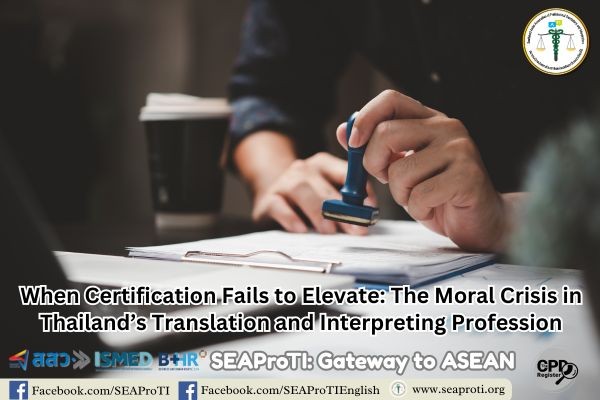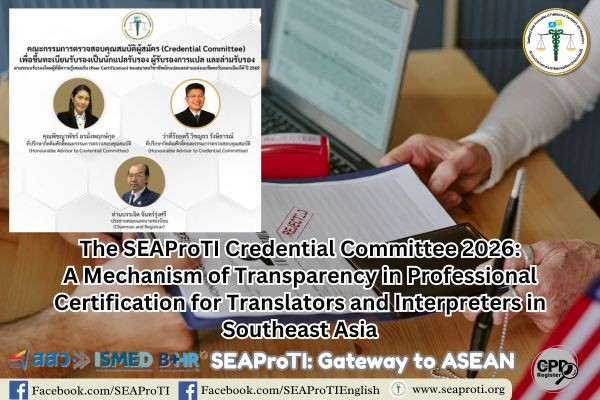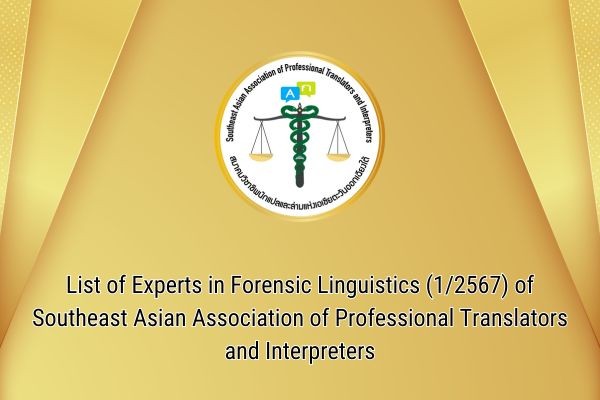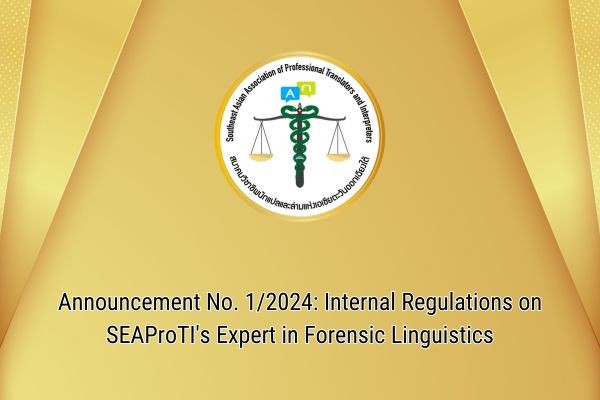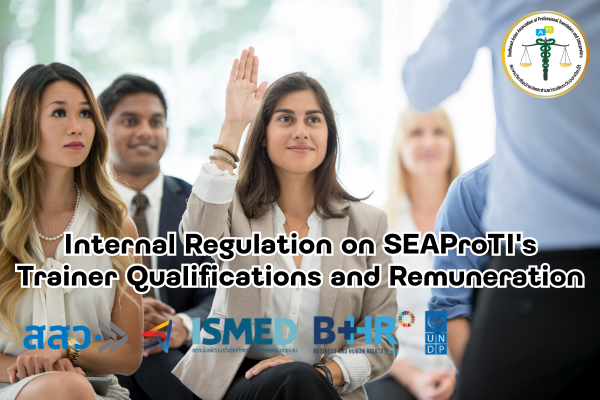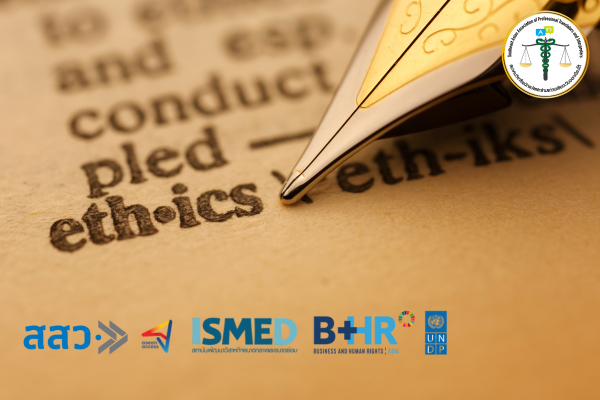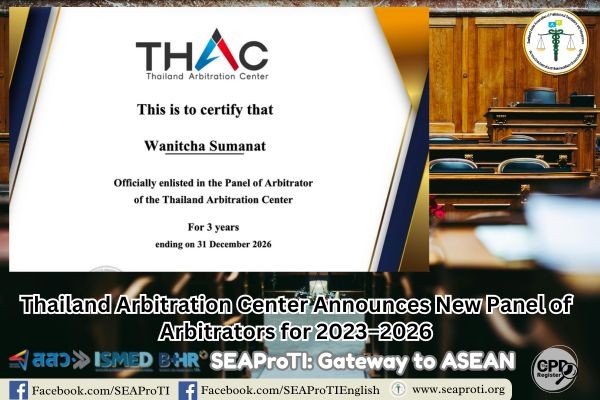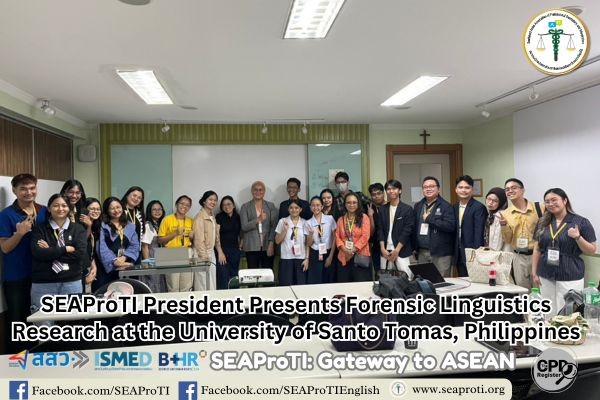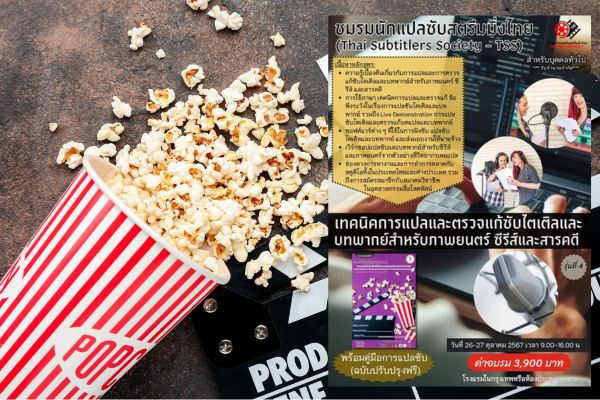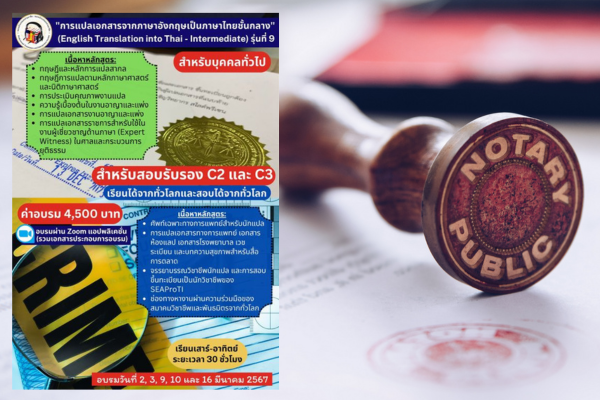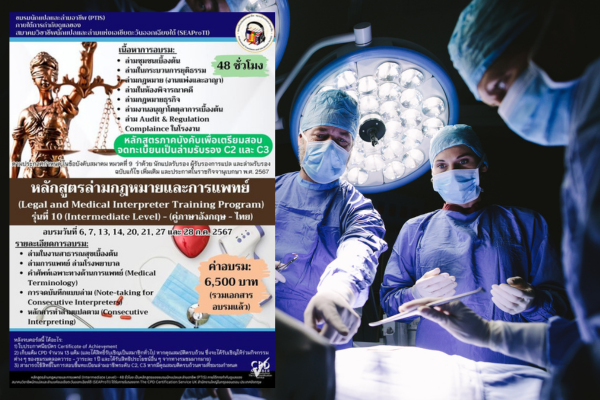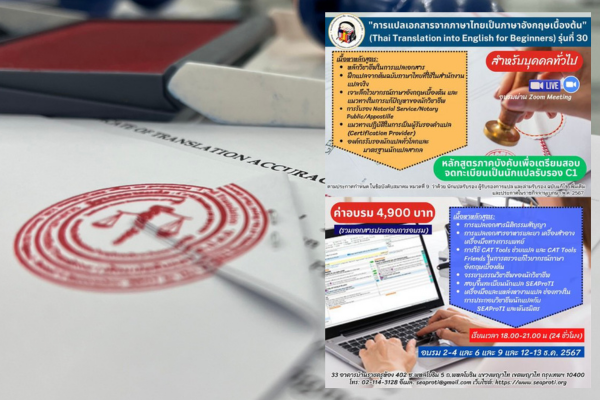Critical Discourse Analysis of Thailand’s Statement
On the Misrepresentation of Comments by the Second Army Area Commander
Author: Wanitcha Sumanat, the president of the Southeast Asian Association of Professional Translators and Interpreters
11 August 2025, Bangkok – This article examines the Ministry of Foreign Affairs of Thailand’s statement regarding the misrepresentation of comments made by the Second Army Area Commander, as referenced in a statement by Cambodia’s Ministry of National Defence on 10 August 2025. Using the framework of Critical Discourse Analysis (CDA) and van Dijk’s Ideological Square, the study explores how linguistic strategies are employed to construct a positive image of Thailand and a negative image of Cambodia. The findings reveal that the statement strategically combines institutional and legal framing with peace-oriented discourse to strengthen Thailand’s credibility in the international arena, while framing the opposing party as distorting facts and undermining the atmosphere for dialogue.
Introduction
In the context of the Thai–Cambodian border dispute, diplomatic discourse serves as a key tool for positioning, rebuttal, and legitimization in the eyes of the international community (Fairclough, 2015). The Ministry of Foreign Affairs’ statement on 10 August 2025 is an example of using language to:
(1) deny allegations with institutional backing,
(2) present Thailand as a party adhering to international agreements, and
(3) frame the opposing party as engaging in misinformation.
Analytical Framework
This study adopts Critical Discourse Analysis (CDA), following van Dijk (2006) and Fairclough (2015), to examine:
- How language is used to construct power relations and dominance.
- How lexical choices and syntactic structures reflect the speaker’s ideology.
How the Ideological Square is employed to position “us” and “them.”
Findings
Framing the Issue
The term “misrepresentation” appears in the opening sentence, immediately framing Cambodia’s statement as false. In English, the phrase place on record is used to convey official formality and evidence-based credibility.
Legitimacy Claim
The statement cites the “Royal Thai Army” as confirming the facts, invoking institutional authority to enhance credibility. References to the GBC and RBC meetings frame Thailand’s actions within established legal and institutional mechanisms.
Positive Self-Presentation
Phrases such as “stands ready to take part” and “strict adherence” portray Thailand as cooperative and law-abiding, aligning with the “emphasize our good” strategy in the Ideological Square.
Negative Other-Presentation
Terms such as “false information” and “fake news” delegitimize the opposing party, signaling to the international audience that the other side undermines peace-building efforts.
Ideological Square Analysis
| Strategy in Ideological Square (van Dijk, 2006) | Example from the Statement | Discursive Effect |
|---|---|---|
| Emphasize Our Good Properties | “Strict adherence to the terms of the ceasefire” | Portrays Thailand as reasonable and compliant with agreements |
| Mitigate Our Bad Properties | “Has not redeployed any of its forces to encroach” | Reduces perception of potential wrongdoing |
| Emphasize Their Bad Properties | “False information or fake news,” “misrepresentation” | Frames Cambodia as unreliable |
| Mitigate Their Good Properties | Omits references to Cambodia’s cooperative actions | Minimizes positive perception of the other side |
Conclusion
The statement demonstrates how diplomatic language functions not merely to convey facts but also to defend against allegations, strengthen self-image, and delegitimize the opponent. Through framing, institutional authority, and the Ideological Square, the discourse positions Thailand as lawful and peace-oriented, while portraying Cambodia as distorting facts. This underscores that diplomatic discourse is a site of ideological struggle and meaning-making before the international community.
References
- Fairclough, N. (2015). Language and power (3rd ed.). Routledge.
- van Dijk, T. A. (2006). Ideology and discourse analysis. Journal of Political Ideologies, 11(2), 115–140. https://doi.org/10.1080/13569310600687908
- Statement on the misrepresentation of comments made by Thailand’s Second Army Area Commander
About SEAProTI Certified Translators, Certification Providers, and Interpreters
The Southeast Asian Association of Professional Translators and Interpreters (SEAProTI) has published official guidelines and eligibility criteria for individuals seeking registration as Certified Translators, Translation Certification Providers, and Certified Interpreters under Chapter 9 and Chapter 10 of the Royal Thai Government Gazette, issued by the Secretariat of the Cabinet, Office of the Prime Minister, on 25 July 2024 (Vol. 141, Part 66 Ng, p. 100). Full text available at: The Royal Thai Government Gazette
การวิเคราะห์เชิงวาทกรรมวิพากษ์ (Critical Discourse Analysis)
คำแถลงกรณีการบิดเบือนคำกล่าวของแม่ทัพภาคที่ 2 ของไทย
ผู้เขียน วณิชชา สุมานัส นายกสมาคมวิชาชีพนักแปลและล่ามแห่งเอเชียตะวันออกเฉียงใต้ (SEAProTI)
11 สิงหาคม 2568, กรุงเทพมหานคร – บทความนี้วิเคราะห์คำแถลงของกระทรวงการต่างประเทศไทยในกรณีการบิดเบือนคำสัมภาษณ์ของแม่ทัพภาคที่ 2 ตามแถลงการณ์ของกระทรวงกลาโหมกัมพูชาเมื่อวันที่ 10 สิงหาคม 2568 โดยใช้กรอบแนวคิดการวิเคราะห์วาทกรรมวิพากษ์ (Critical Discourse Analysis: CDA) และโมเดล Ideological Square ของ van Dijk เพื่อทำความเข้าใจกลยุทธ์การใช้ภาษาในเชิงการเมือง การสร้างภาพลักษณ์เชิงบวกของตนเอง และการทำให้คู่ขัดแย้งมีภาพลักษณ์เชิงลบ ผลการวิเคราะห์พบว่า คำแถลงใช้กลยุทธ์เชิงสถาบันและกฎหมาย (institutional and legal framing) ควบคู่กับการสื่อสารเชิงสร้างสันติ (peace-oriented discourse) เพื่อสร้างความน่าเชื่อถือในเวทีระหว่างประเทศ ขณะเดียวกันก็ลดทอนความน่าเชื่อถือของคู่ขัดแย้งผ่านการ framing ว่าเป็นผู้บิดเบือนข้อเท็จจริง
บทนำ
ในบริบทความขัดแย้งชายแดนไทย–กัมพูชา วาทกรรมทางการทูตเป็นเครื่องมือสำคัญที่ใช้ในการกำหนดท่าที การตอบโต้ และการสร้างความชอบธรรมในสายตาประชาคมโลก (Fairclough, 2015) กรณีคำแถลงของกระทรวงการต่างประเทศเมื่อวันที่ 10 สิงหาคม 2568 เป็นตัวอย่างของการใช้ภาษาเพื่อ
(1) ปฏิเสธข้อกล่าวหาอย่างมีหลักฐานเชิงสถาบัน
(2) สร้างภาพลักษณ์ตนเองในฐานะผู้ปฏิบัติตามข้อตกลงระหว่างประเทศ
(3) ทำให้คู่ขัดแย้งมีภาพลักษณ์เชิงลบผ่านการกล่าวถึงการบิดเบือนข้อมูล
กรอบแนวคิดการวิเคราะห์
งานวิจัยนี้ใช้ Critical Discourse Analysis (CDA) ตามแนวทางของ van Dijk (2006) และ Fairclough (2015) เพื่อวิเคราะห์ว่า
- ภาษา ถูกใช้เพื่อสร้างความสัมพันธ์เชิงอำนาจและการครอบงำอย่างไร
- การเลือกคำ (lexical choice) และ โครงสร้างประโยค (syntax) สะท้อนอุดมการณ์ของผู้พูดอย่างไร
- การใช้ Ideological Square ในการจัดวางภาพลักษณ์ของ “เรา” และ “เขา”
ผลการวิเคราะห์
การกำหนดกรอบประเด็น (Framing the Issue)
คำว่า “การบิดเบือน” (misrepresentation) ปรากฏตั้งแต่ประโยคแรก ทำหน้าที่สร้างน้ำหนักทางความหมายให้ผู้ฟังรับรู้ว่าคู่ขัดแย้งเป็นฝ่ายเผยแพร่ข้อมูลที่ไม่ถูกต้อง ขณะที่ภาษาอังกฤษเลือกใช้คำว่า place on record เพื่อเสริมภาพความเป็นทางการและมีหลักฐานรองรับ
การสร้างความชอบธรรม (Legitimacy Claim)
คำแถลงอ้างอิง “กองทัพบกได้ยืนยันแล้ว” ซึ่งเป็นการใช้ institutional authority เพื่อเพิ่มน้ำหนักความน่าเชื่อถือ พร้อมทั้งอ้างถึงการประชุม GBC และ RBC ในฐานะกลไกทางกฎหมายและสถาบันระหว่างประเทศ
การสร้างภาพลักษณ์เชิงบวกของตนเอง (Positive Self-Presentation)
คำอย่าง “พร้อมที่จะเข้าร่วมประชุม”, “ยึดมั่น…อย่างเคร่งครัด” สื่อว่าฝ่ายไทยเป็นผู้รักษาข้อตกลงและมุ่งสันติภาพ ซึ่งสอดคล้องกับกลยุทธ์การยกย่องคุณค่าของ “เรา” ในโมเดล Ideological Square
การทำให้คู่ขัดแย้งเป็นผู้มีภาพลักษณ์เชิงลบ (Negative Other-Presentation)
การใช้คำว่า “ข้อมูลอันเป็นเท็จหรือข่าวปลอม” และ “บิดเบือน” เป็นการลดความน่าเชื่อถือของคู่ขัดแย้ง พร้อมสื่อสารต่อประชาคมโลกว่าฝ่ายนั้นมีพฤติกรรมขัดต่อบรรยากาศการเจรจา
ตารางการวิเคราะห์เชิง Ideological Square
| กลยุทธ์ใน Ideological Square (van Dijk, 2006) | ตัวอย่างจากคำแถลง | ผลเชิงวาทกรรม |
|---|---|---|
| เน้นสิ่งดีของเรา (Emphasize Our Good Properties) | “ยึดมั่นในการปฏิบัติตามข้อตกลงหยุดยิงอย่างเคร่งครัด” | สร้างภาพฝ่ายไทยเป็นผู้มีเหตุผลและปฏิบัติตามกติกา |
| ลดสิ่งไม่ดีของเรา (Mitigate Our Bad Properties) | ไม่กล่าวถึงกรณีที่ไทยอาจถูกรายงานว่าละเมิด แต่ใช้ถ้อยคำ “ไม่ได้มีการเคลื่อนย้ายกำลังพลเพื่อรุกล้ำ” | ลดโอกาสที่ผู้ฟังจะมองไทยในแง่ลบ |
| เน้นสิ่งไม่ดีของเขา (Emphasize Their Bad Properties) | “ข้อมูลอันเป็นเท็จหรือข่าวปลอม”, “บิดเบือน” | ทำให้คู่ขัดแย้งมีภาพลักษณ์ไม่น่าเชื่อถือ |
| ลดสิ่งดีของเขา (Mitigate Their Good Properties) | ไม่กล่าวถึงความร่วมมือหรือการปฏิบัติตามข้อตกลงของกัมพูชา | ลดการให้เครดิตแก่คู่ขัดแย้งในเชิงบวก |
สรุป
คำแถลงดังกล่าวเป็นตัวอย่างของการใช้ภาษาในเชิงการทูตเพื่อปฏิเสธข้อกล่าวหา เสริมภาพลักษณ์เชิงบวกของตน และลดความน่าเชื่อถือของคู่ขัดแย้ง ผ่านกลยุทธ์ framing, institutional authority, และ Ideological Square การวิเคราะห์นี้ชี้ให้เห็นว่า วาทกรรมทางการทูตไม่ได้เพียงสื่อสารข้อเท็จจริง แต่ยังเป็นพื้นที่ต่อสู้เชิงอุดมการณ์และการสร้างความหมายต่อประชาคมโลก
เอกสารอ้างอิง
- Fairclough, N. (2015). Language and power (3rd ed.). Routledge.
- van Dijk, T. A. (2006). Ideology and discourse analysis. Journal of Political Ideologies, 11(2), 115–140. https://doi.org/10.1080/13569310600687908
- คำแถลงกรณีการบิดเบือนคำกล่าวของแม่ทัพภาคที่ 2 ของไทย
เกี่ยวกับนักแปลรับรอง ผู้รับรองการแปล และล่ามรับรองของสมาคมวิชาชีพนักแปลและล่ามแห่งเอเชียตะวันออกเฉียงใต้
สมาคมวิชาชีพนักแปลและล่ามแห่งเอเชียตะวันออกเฉียงใต้ (SEAProTI) ได้ประกาศหลักเกณฑ์และคุณสมบัติผู้ที่ขึ้นทะเบียนเป็น “นักแปลรับรอง (Certified Translators) และผู้รับรองการแปล (Translation Certification Providers) และล่ามรับรอง (Certified Interpreters)” ของสมาคม หมวดที่ 9 และหมวดที่ 10 ในราชกิจจานุเบกษา ของสำนักเลขาธิการคณะรัฐมนตรี ในสำนักนายกรัฐมนตรี แห่งราชอาณาจักรไทย ลงวันที่ 25 ก.ค. 2567 เล่มที่ 141 ตอนที่ 66 ง หน้า 100 อ่านฉบับเต็มได้ที่: นักแปลรับรอง ผู้รับรองการแปล และล่ามรับรอง
